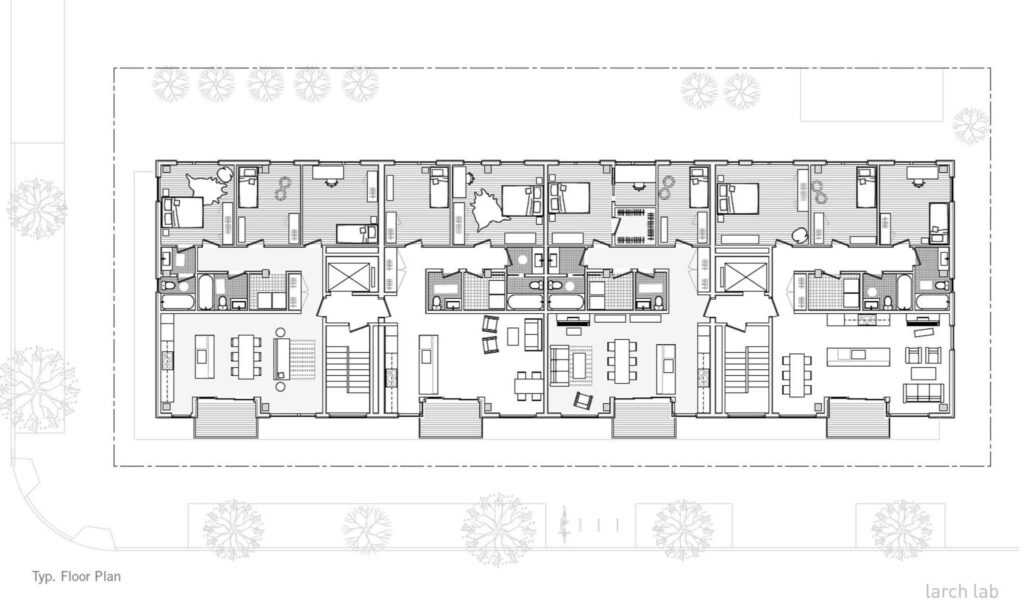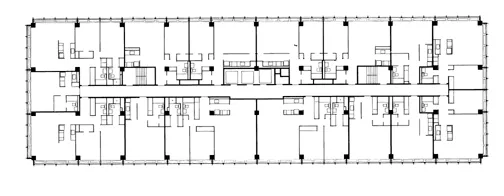Most state and city building codes, including Virginia’s, require apartment and condo buildings to include multiple exit stairways for buildings over three to five stories. Modifying building codes to allow multifamily buildings to be built with more efficient single-stair designs would make it easier to build on small or irregularly shaped lots that are common in American cities. These reforms also make providing units with more bedrooms necessary for families easier. Although fire safety has historically been building code officials’ primary rationale for requiring multiple stairways, these concerns have largely been mitigated by advances in building materials and automatic sprinklers since the mid-20th Century.
For its 2024 term, Virginia’s legislature is considering single-stair building code reforms–which, under the state’s current rules, is limited to three-story buildings. Any building in Virginia that exceeds this limit needs multiple exit stairwells accessible from the entire floor, usually via a long hallway. This arrangement leads to long, dark hallways for condo and apartment buildings and units with windows only on one side. While the state’s three-story limit is typical for the U.S., it is far below European limits that often exceed eight stories. In the U.S., cities like Seattle and New York already have six-story limits.
Legislators introduced two bills (1) (2) directing the Commonwealth’s Board of Housing and Community Development (BHCD) to evaluate allowing single-stair multifamily construction of up to six stories for this year’s legislative session. Both bills have passed their respective houses and recently passed final consideration in the other chamber with amendments.The House version passed both chambers unanimously on March 5th and is headed to Governor Glenn Youngkin’s desk.
Why single-stair reform matters for Virginia
Single-stair building code reforms are an essential supply-side policy change. As we have written, single-stair designs (Figure 1) were standard in the U.S. before World War 2 and are still common in other industrialized countries. The inherent design flexibility compared to a now-common double-loaded corridor (Figure 2) makes building multifamily on small or irregularly shaped lots found in many cities easier. The same flexibility also helps accommodate multi-bedroom apartments that help families live closer to economic opportunity.


While fire safety is critical, regulations are often based on anecdotes rather than rigorous study. Multifamily buildings in the U.S. outperform single-family homes for fire safety. However, this is primarily because of improved materials, working smoke alarms, and automatic sprinklers–not because they have multiple exit stairs. Organizations like the National Fire Protection Association and the International Standards Organization set testing standards for building materials to confirm their ability to resist combustion or protect adjacent spaces from a fire. These high-performance materials–many of which didn’t exist when the earliest dual stairway requirements were established–help contain fires and prevent wide conflagrations.
If adopted, the Virginia bill would direct the BHCD to convene a stakeholder group, including firefighting professionals, to advise the BHCD on how to modify the existing building code to allow single-stair multifamily construction up to six stories to unlock more cost-effective and neighborhood-scale multifamily construction. The stakeholder group will submit its recommendations to BHCD by December 1, 2024. It will be necessary for advocates to remain engaged with the rulemaking process in 2024 to ensure the stakeholder group fully understands the benefits to be unlocked by allowing single-stair construction up to the legislative maximum of six stories.
If the six-story maximum is implemented, it will allow the Commonwealth to increase the housing supply for individuals and families while delivering fire safety performance exceeding detached single-family homes. With more single-stair options in the state building code, Virginians can expect more housing options that are safer, better for families, and easier to build than the alternative.